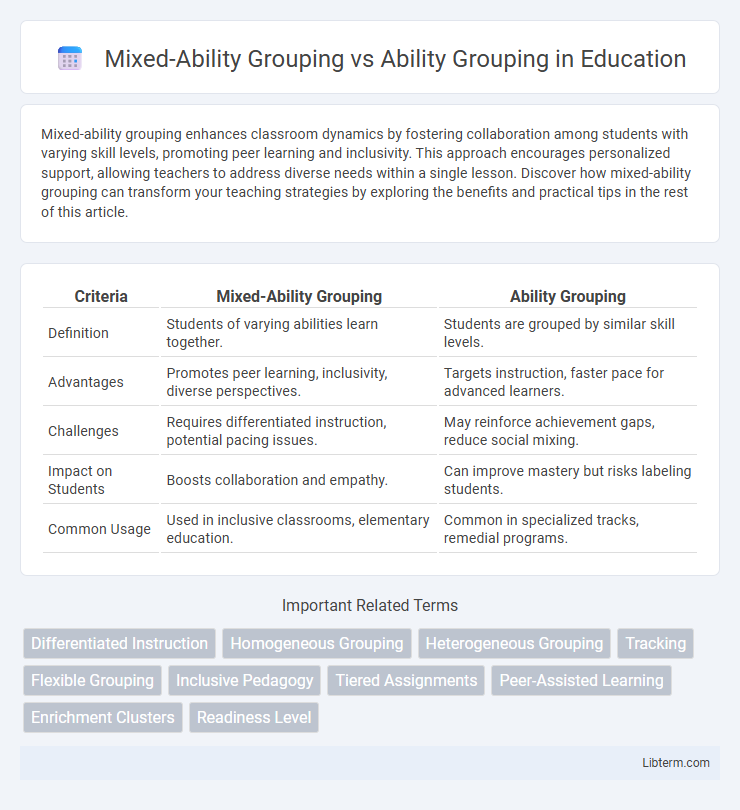Mixed-ability grouping enhances classroom dynamics by fostering collaboration among students with varying skill levels, promoting peer learning and inclusivity. This approach encourages personalized support, allowing teachers to address diverse needs within a single lesson. Discover how mixed-ability grouping can transform your teaching strategies by exploring the benefits and practical tips in the rest of this article.
Table of Comparison
| Criteria | Mixed-Ability Grouping | Ability Grouping |
|---|---|---|
| Definition | Students of varying abilities learn together. | Students are grouped by similar skill levels. |
| Advantages | Promotes peer learning, inclusivity, diverse perspectives. | Targets instruction, faster pace for advanced learners. |
| Challenges | Requires differentiated instruction, potential pacing issues. | May reinforce achievement gaps, reduce social mixing. |
| Impact on Students | Boosts collaboration and empathy. | Can improve mastery but risks labeling students. |
| Common Usage | Used in inclusive classrooms, elementary education. | Common in specialized tracks, remedial programs. |
Introduction to Grouping Strategies in Education
Mixed-ability grouping promotes inclusive classrooms by integrating students with diverse skill levels, fostering peer learning and collaboration. In contrast, ability grouping separates students based on their proficiency, often aiming to tailor instruction to specific learning needs but risking increased social stratification. Choosing between these strategies depends on educational goals, classroom dynamics, and the emphasis on equity versus targeted skill development.
Defining Mixed-Ability Grouping
Mixed-ability grouping involves organizing students of diverse skill levels and learning needs together within the same instructional setting, promoting peer learning and collaboration. This approach contrasts with ability grouping, which separates students based on their perceived academic performance or skill proficiency. Mixed-ability groups enhance differentiated instruction and foster inclusive classroom environments where all learners can engage and grow.
Defining Ability Grouping
Ability grouping organizes students by similar skill levels or academic performance, enabling targeted instruction that matches their current capabilities. Mixed-ability grouping combines learners of varied proficiency within one group, promoting peer support and diverse perspectives. Defining ability grouping involves categorizing students based on assessments, standardized test scores, or teacher evaluations to facilitate tailored educational strategies.
Historical Context and Evolution
Mixed-ability grouping emerged as an inclusive approach during the mid-20th century, challenging the rigid ability grouping practices that had dominated earlier education systems since the 19th century. Ability grouping, often linked to tracking and streaming, historically reinforced social inequalities by segregating students based on perceived intelligence or academic skills. Over time, educational reforms and research advocating for equity and differentiated instruction led to the evolution and increased adoption of mixed-ability classrooms, emphasizing diverse learning needs and collaborative learning environments.
Academic Outcomes: Comparing Results
Mixed-ability grouping promotes diverse interactions that enhance critical thinking and collaboration, leading to more consistent academic gains across all student levels. Ability grouping often results in higher achievement for advanced students but may create achievement gaps, limiting peer learning opportunities for lower-performing students. Studies show mixed-ability classrooms foster inclusive environments with improved overall academic outcomes, whereas ability grouping can reinforce disparities in educational achievement.
Social and Emotional Impacts
Mixed-ability grouping fosters increased empathy, collaboration, and peer support, positively influencing students' social development and emotional well-being. In contrast, ability grouping can lead to social stigmatization, reduced self-esteem, and heightened anxiety among lower-ability students due to perceived labeling and segregation. Research indicates that mixed-ability settings promote inclusive peer relationships and emotional resilience, enhancing overall student engagement and motivation.
Equity and Inclusion Considerations
Mixed-ability grouping promotes equity by fostering an inclusive environment where students of diverse skill levels collaborate, enhancing peer learning and reducing stigmatization associated with fixed ability labels. In contrast, ability grouping often reinforces achievement gaps and social divides by segregating students based on perceived performance, which can limit access to resources for lower-ability groups. Emphasizing mixed-ability practices supports differentiated instruction and culturally responsive teaching, advancing equitable educational outcomes and inclusive classroom dynamics.
Teacher Perspectives and Challenges
Teachers report that mixed-ability grouping fosters collaboration and peer learning, but it requires differentiated instruction to meet diverse student needs effectively. In contrast, ability grouping simplifies lesson planning by targeting specific skill levels but may reinforce fixed mindsets and limit social interaction across abilities. Managing classroom dynamics and ensuring equitable participation remain key challenges in both grouping strategies.
Best Practices for Implementing Grouping
Effective implementation of mixed-ability grouping involves tailoring instruction to diverse learning needs through differentiated tasks and collaborative activities that promote peer learning and social development. Best practices for ability grouping include regularly reassessing student progress to ensure flexible grouping, maintaining high expectations across all groups, and providing targeted support to prevent stigmatization. Both grouping strategies require clear learning objectives, ongoing formative assessments, and teacher training to optimize academic outcomes and student engagement.
Conclusion: Choosing the Right Approach
Selecting the appropriate grouping strategy depends on educational goals, student diversity, and resource availability. Mixed-ability grouping fosters collaboration and peer learning, supporting social development and inclusivity. Ability grouping can offer targeted instruction but may risk reinforcing achievement gaps if not implemented thoughtfully.
Mixed-Ability Grouping Infographic

 libterm.com
libterm.com